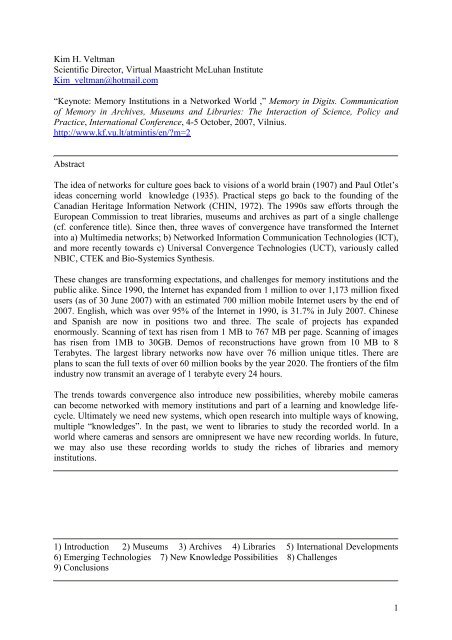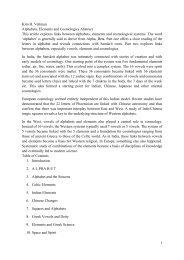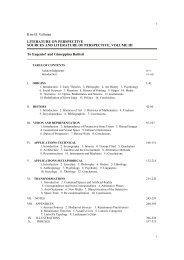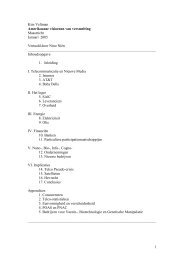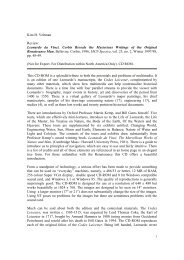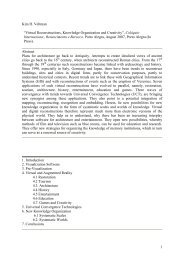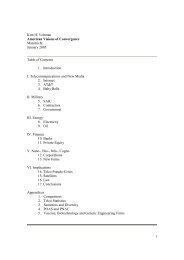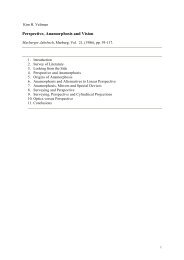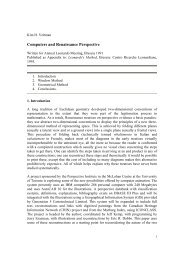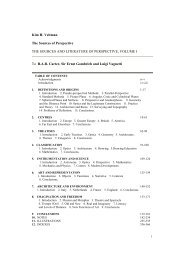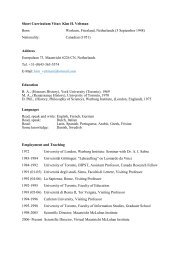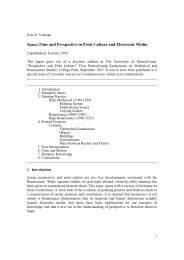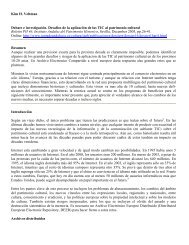Read full article - Virtual Maastricht McLuhan Institute
Read full article - Virtual Maastricht McLuhan Institute
Read full article - Virtual Maastricht McLuhan Institute
Create successful ePaper yourself
Turn your PDF publications into a flip-book with our unique Google optimized e-Paper software.
Kim H. Veltman<br />
Scientific Director, <strong>Virtual</strong> <strong>Maastricht</strong> <strong>McLuhan</strong> <strong>Institute</strong><br />
Kim_veltman@hotmail.com<br />
“Keynote: Memory Institutions in a Networked World ,” Memory in Digits. Communication<br />
of Memory in Archives, Museums and Libraries: The Interaction of Science, Policy and<br />
Practice, International Conference, 4-5 October, 2007, Vilnius.<br />
http://www.kf.vu.lt/atmintis/en/m=2<br />
Abstract<br />
The idea of networks for culture goes back to visions of a world brain (1907) and Paul Otlet’s<br />
ideas concerning world knowledge (1935). Practical steps go back to the founding of the<br />
Canadian Heritage Information Network (CHIN, 1972). The 1990s saw efforts through the<br />
European Commission to treat libraries, museums and archives as part of a single challenge<br />
(cf. conference title). Since then, three waves of convergence have transformed the Internet<br />
into a) Multimedia networks; b) Networked Information Communication Technologies (ICT),<br />
and more recently towards c) Universal Convergence Technologies (UCT), variously called<br />
NBIC, CTEK and Bio-Systemics Synthesis.<br />
These changes are transforming expectations, and challenges for memory institutions and the<br />
public alike. Since 1990, the Internet has expanded from 1 million to over 1,173 million fixed<br />
users (as of 30 June 2007) with an estimated 700 million mobile Internet users by the end of<br />
2007. English, which was over 95% of the Internet in 1990, is 31.7% in July 2007. Chinese<br />
and Spanish are now in positions two and three. The scale of projects has expanded<br />
enormously. Scanning of text has risen from 1 MB to 767 MB per page. Scanning of images<br />
has risen from 1MB to 30GB. Demos of reconstructions have grown from 10 MB to 8<br />
Terabytes. The largest library networks now have over 76 million unique titles. There are<br />
plans to scan the <strong>full</strong> texts of over 60 million books by the year 2020. The frontiers of the film<br />
industry now transmit an average of 1 terabyte every 24 hours.<br />
The trends towards convergence also introduce new possibilities, whereby mobile cameras<br />
can become networked with memory institutions and part of a learning and knowledge lifecycle.<br />
Ultimately we need new systems, which open research into multiple ways of knowing,<br />
multiple “knowledges”. In the past, we went to libraries to study the recorded world. In a<br />
world where cameras and sensors are omnipresent we have new recording worlds. In future,<br />
we may also use these recording worlds to study the riches of libraries and memory<br />
institutions.<br />
1) Introduction 2) Museums 3) Archives 4) Libraries 5) International Developments<br />
6) Emerging Technologies 7) New Knowledge Possibilities 8) Challenges<br />
9) Conclusions<br />
1
1) Introduction<br />
The idea of networks for knowledge and culture goes back to visions of a world brain (Gehirn<br />
der Welt, 1907). 1 It was taken up by Ostwald (1912) and subsequently by H.G. Wells (1937)<br />
and Teilhard de Chardin (1946). This became the planetary brain with Otter G'Zell (1970),<br />
popularized by Joel de Rosnay. It has since become fashionable through the buzzword of<br />
collective intelligence. 2 Active in this vision for a global brain and a global access to world<br />
knowledge and culture were two Belgians, Paul Otlet and Henri LaFontaine. They developed<br />
the Mundaneum, created the Universal Decimal Classification, and laid the foundations for<br />
systematic bibliographical control of secondary literature. In 1935, Paul Otlet outlined his <strong>full</strong><br />
vision:<br />
"Man would no longer need documentation if he were assimilated into an omniscient<br />
being - as with God himself. But to a less ultimate degree, a technology will be created<br />
acting at a distance and combining radio, X-rays, cinema and microscopic<br />
photography. Everything in the universe, and everything of man, would be registered<br />
at a distance as it was produced. In this way a moving image of the world will be<br />
established, a true mirror of his memory. From a distance, everyone will be able to<br />
read text, enlarged and limited to the desired subject, projected on an individual<br />
screen. In this way, everyone from his armchair will be able to contemplate creation,<br />
as a whole or in certain of its parts." 3<br />
A decade later, Vannevar Bush outlined his widely publicized: “As we may Think” (1945). 4<br />
The Internet began in England in 1968. Four years later, the year that the UNESCO World<br />
Heritage Convention 5 was signed, the Canadian Heritage Information Network (CHIN, 1972) 6<br />
was founded.<br />
2) Museums<br />
It was nearly two decades before Europe launched its European Museum Network (EMN)<br />
project (1989-1992). When the project began, its founders were assured that by the time the<br />
project was finished, the Internet infrastructure would be <strong>full</strong>y in place. Although this proved<br />
overoptimistic, the next project, Remote Access to European Archives (RAMA) continued the<br />
vision in a similarly optimistic tone:<br />
“The RAMA project is one of the major initiatives in Europe sponsored by the<br />
Commission of the European Communities under the RACE Programme. Its goal to<br />
offer an open tool for any professional user in a telecommunication service<br />
environment, to interface with archives, databases, and LAN software currently<br />
existing in the museums. The users are validating all the phases of the project, thus<br />
ensuring the final acceptance of the product. The result is an open, scalable, and<br />
interoperable architecture, implemented as a client server approach over a low cost<br />
equipment set.” 7<br />
RAMA (1992-1995), was followed by the “Multimedia European Network of High Quality<br />
Image Registration (MENHIR) project, which attempted to build an Internet catalogue of<br />
museum images based on a unique ISO standard. It resulted in an online catalogue of 120,000<br />
images from a variety of large, small and medium museums in Europe.”MENHIR (1996-<br />
1997) was followed by OpenHeritage (2001-) which networked “30 museums in five regions<br />
of Europe with a novel multimedia collection management system.” 8 The European<br />
2
Commission launched a number of other initiatives including the Memorandum of<br />
Understanding (MOU) for Multimedia Access to Europe’s Cultural Heritage and the MEDICI<br />
Framework. 9 This initiative brought together well over 1000 signatories. E-Culture Net 10<br />
reviewed progress and offered a vision of what lay ahead. It outlined the need for a<br />
Distributed European Electronic Repository (DEER) with a <strong>Virtual</strong> Reference Room and<br />
<strong>Virtual</strong> Agora.<br />
While none of these initiatives created <strong>full</strong>-scale networks as some had hoped, a great deal<br />
was achieved. The 1990s saw efforts through the European Commission to treat libraries,<br />
museums and archives as part of a single challenge and introduced the idea of memory<br />
institutions. Other than the conference title, this has led to concrete projects such as:<br />
Gemeinsames Internetportal für Bibliotheken, Archive und Museen (BAM). 11<br />
Major museums such as the Louvre, which had no commitment to an online presence in the<br />
1980s, now make their collections accessible online 12 through four databases 13 : 1) paintings<br />
with 35,000 works of art; 2) drawings with 140,000 works on paper, 3) American artists with<br />
1,700 works produced by United States artists that entered the national collections of France<br />
before 1940, and 4) developed by the Direction des Musées de France, Joconde, which<br />
“incorporates 120,000 descriptions of drawings, prints, and paintings from the 7th century to<br />
the present day, from the collections of over sixty French museums.” In addition, the Centre<br />
de Recherche et Restauration des Musées de France (C2RMF) 14 has developed further<br />
databases and launched the idea of a European network for conservation analogous to the<br />
Canadian Conservation <strong>Institute</strong> (CCI). 15 As a result, a single museum complex now makes<br />
available more images than all the networked efforts of fifteen years ago. Meanwhile, the 33<br />
national museums of France are also online. 16<br />
These French experiences in the direction of a cultural portal are a starting point for the<br />
Multilingual Inventory of Cultural Heritage in Europe (MICHAEL) project. 17 This is very<br />
important because it makes accessible collections from over 3,000 institutions/resources<br />
(figure 1), including significant, smaller collections such as the Dulwich Picture Gallery. 18<br />
There is still much to be done. The present site with three languages (English, French, Italian)<br />
is a long way from the vision of Accès Multilingue au Patrimoine (AMP) 19 outlined by the<br />
French Ministère de la Culture. The maps on the present site do not yet work properly.<br />
Clicking on Italy or Russia leads to the UK, while clicking on Sweden or Spain leads to<br />
France. But these are minor details. 20<br />
Topic<br />
Institutions/Resources<br />
Education 74<br />
Science 499<br />
Culture 1690<br />
Social and Human Sciences 548<br />
Information and Communication 139<br />
Politics, Law and Economics 326<br />
Figure 1. A list of topics and institutions/resources covered by the MICHAEL project. 21<br />
Another project by Museen.de, by Rainer Göttlinger gives a better glimpse of where this<br />
approach is going. 22 When one sees the extraordinary developments using maps through<br />
projects such as Google Earth or Microsoft’s <strong>Virtual</strong> Earth, 23 which continue the vision of<br />
European projects such as Terravision, 24 the enormous potentials of this approach are evident.<br />
3
A challenge remains of ensuring that the technologies developed by such private enterprise<br />
companies become available and integrated in the case of cultural sites, which are in the<br />
public domain as part of the public good.<br />
Since 2000, there have been two significant developments. First, there have been moves<br />
towards e-Content (see § 4 below). Second, the Commission has recognized the importance<br />
of policy accords at the governmental level. This began with European content in global<br />
networks - Coordination mechanisms for digitisation programmes (Lund Action Plan,<br />
2001), 25 which led to the NEtwoRk for Valorising Activities in digitisation (MINERVA). 26<br />
MICHAEL is part of this initiative. In the longer term, such policy work needs to evolve on a<br />
whole range of levels including physical infrastructures, long-term preservation needs, and<br />
multimedia contents in the widest sense of the word. It is very important for such policy<br />
actions, which have thus far been short-term European projects, to be integrated into the longterm<br />
workings of governments. Networks as projects are a good beginning, but networks need<br />
to become part of long-term infrastructures in order to become an important dimension of an<br />
evolving knowledge society.<br />
3) Archives<br />
In the realm of archives, pioneering work was done by the Scottish Cultural Resources Access<br />
Network (SCRAN), which has now become the Scottish Archive Network (SCAN). 27 In July<br />
2003, SCAN in conjunction with the National Archives of Scotland (NAS) launched Scottish<br />
Documents.com, a project aimed at digitisation and preservation of over 520,000 Scottish<br />
wills and testaments. 28 Until June 2005, SCRAN also had an e-commerce website provided<br />
free access to the index to wills and testaments of Scots from 1500 to 1901. These have now<br />
become part of ScotlandsPeople, “one of the largest online sources of original genealogical<br />
information, with almost 50 million records to access…and the opportunity to order high<br />
quality digital images of the documents by e-mail.” 29<br />
The German Social Science Infra-structure Services e.V (GESIS) 30 has important collections<br />
at the national level and has introduced the East European Data Archive Network (EDAN). 31<br />
The United Kingdom has made significant contributions through JISC (Joint Information<br />
Systems Committee), 32 which has also helped launch an Arts and Humanities e-Science<br />
Support Centre (AHeSCC). 33 France has made contributions through its Maisons des Sciences<br />
de l'Homme en France (MSH), 34 which has also launched a significant project for Mapping of<br />
European Social Sciences and Humanities (MORESS). 35 The Netherlands has Data Archiving<br />
and Networked Services (DANS). The UK, Netherlands France and Germany are cooperating<br />
together on a Digital Research Infrastructure for the Arts and Humanities<br />
(DARIAH). 36 This is part of an European Strategy Forum on Research Infrastructures<br />
(ESFRI). 37<br />
Since 2000, the vision of e-science has moved from plans to a series of projects starting with a<br />
systematic approach in the United Kingdom 38 and an increasing series of grid projects<br />
including: DataGrid 39 and Enabling Grids for E-sciencE project (EGEE). 40 In 2006, a<br />
Workshop on European Infrastructure for Repositories of Scientific Information 41 explored<br />
possible approaches to pan-European knowledge infrastructure and found that whilst existing:<br />
“repositories contain very large holdings, often many hundreds of thousands of digital objects,<br />
and whilst a great diversity of multimedia objects—documents, datasets, images, video,<br />
publications, transcriptions, reference works, etc—are included, they represent only a tiny<br />
fraction of what will be possible in a pan- European knowledge infrastructure of the future.”<br />
4
While very laudable the figures were more than slightly off. While experimental grid projects<br />
are dealing with hundreds of thousands of items, by 2006, the Karlsruhe <strong>Virtual</strong> Catalogue, in<br />
the regular library world, attained 500 million items. Admittedly the great majority of these<br />
were titles and not <strong>full</strong>-texts, but even so it remains the case that those intent on creating a<br />
new infrastructure have not always been <strong>full</strong>y informed of existing efforts. Fortunately, the<br />
workshop concluded that: “The pan-European knowledge infrastructure should be built on<br />
existing national and trans-national knowledge infrastructures.” So there is hope that new<br />
integration may lie ahead.<br />
The initial e-science efforts were focussed almost exclusively on e-science but this is<br />
changing. There are projects such as Digital Repository Infrastructure Vision for European<br />
Research (DRIVER) 42 , Digital Library Infrastructure on Grid Enabled technology<br />
(DILIGENT) 43 and TextGrid (Modular platform for collaborative textual editing - a<br />
community grid for the humanities). 44 The German e-Science Conference 2007 (GES2007) 45<br />
included papers on a Federation of Language Archives Enabling Future eHumanities<br />
Scenarios. 46 Terms such as Humanities Computing introduced in the 1980s by pioneers such<br />
Willard McCarty (then Toronto, now London) and Ian Lancashire (Toronto) are becoming the<br />
vogue in Europe and e-Humanities is now becoming fashionable.<br />
While all these steps forward are exciting and significant, it is important to note that most of<br />
this work is on archives in the sense of computer science, namely digital repositories of<br />
materials. With some exceptions, e.g. Scotland, systematic access to traditional archives<br />
remains an open field. Integration of archives at local regional and national levels across<br />
countries is a domain where an enormous amount remains to be done.<br />
4) Libraries<br />
Efforts at automation of library catalogues go back to the 1960s. During the 1970s there were<br />
initial efforts towards national networks, often hampered, especially in Germany, by<br />
infrastructures at state/provincial levels and accompanying mentalities, which had difficulty in<br />
thinking beyond borders. Today, after 35 years of efforts, national networks are a serious<br />
reality and typically range from 10 to 40 million items. Efforts to create a Academic Subject<br />
Gateway Service in Europe (RENARDUS), 47 led to projects for The European Library (TEL)<br />
and more recently the vision of a European Digital library (EDL). 48<br />
Only a decade ago, most libraries only offered access to books, manuscripts and periodicals.<br />
This has changed dramatically. For instance, today the material selection of the German<br />
Gemeinsamer Bibliotheks-verbund (GBV) includes fifteen choices (Figure 2). The European<br />
Library entails 11 choices 49 in a virtual environment in 20 languages that presently (July<br />
2007) allows one to search through the resources of 30 of the 47 national libraries. 50 Within<br />
the next years this will be expanded to include all 47 national libraries.<br />
Books Letters Music<br />
Periodicals (non-online) Movies, Video tapes, etc. Sound recordings<br />
Online periodicals Pictures Data media<br />
Online resources (without periodicals) Maps Microforms<br />
Articles Manuscripts Games, Sculpture, etc<br />
Figure 2. A list of material selection in the GBV. 51<br />
5
We noted earlier that there have been two significant changes within the European<br />
Commission since 2000. One is in co-ordinating policy, The other has been a decision to<br />
become involved in e-Content. Initially, this was more a gesture than a systematic plan. By<br />
2006, partly in response to Google’s announcements to scan the <strong>full</strong> texts of 15 million books<br />
(cf. § 5 below), the European Commission committed itself to scanning the <strong>full</strong>-texts of 6<br />
million books. 52 While this marks an enormous step forward, it has been overshadowed by<br />
other developments around the world.<br />
5) International Developments<br />
The Internet is growing rapidly. It grew from c. 1 million users in 1990 to 200 million in<br />
2000. Despite the dot.com bust in 2001 it has since grown to 1,173 million fixed line users (as<br />
of 30 June, 2007), with an estimated 700 million mobile Internet users by the end of 2007.<br />
English, which was over 95% of the Internet in 1990, is 31.7% in 2007. Chinese and Spanish<br />
are now in positions two and three. The scale of projects has expanded enormously. Scanning<br />
of text has risen from 1 MB to 767 MB per page. Scanning of images has risen from 1MB to<br />
30GB. Demos of reconstructions have grown from 10 MB to 8 Terabytes. The largest library<br />
network, namely WorldCat, now has over 79 million unique titles.<br />
During the 1990s, one of the eleven G7 projects was devoted to a Bibliotheca Universalis<br />
(Pilot Project 5). Since then there have been no less than six projects worldwide with plans to<br />
scan in books. Google is scanning in 10-15 million <strong>full</strong>-texts and has announced that they<br />
have a 300 year plan. The combined effect of these projects will be to scan the <strong>full</strong> texts of<br />
over 60 million books by the year 2020. 53 The enormity of such plans becomes evident when<br />
we recall that in 1950, the largest library in the world scarcely had 10 million books.<br />
There have been parallel developments in the Museum world. The International Council on<br />
Museums (ICOM) 54 has over 21,000 members in 140 countries and sponsors a list with many<br />
thousands of online museums begun initially though the efforts of Jonathan Bowen. 55 The<br />
<strong>Virtual</strong> Museum of Canada sponsored by CHIN now has an image gallery of over 420,000<br />
images; contains more than 150 interactive games and hosts over 500 <strong>Virtual</strong> Exhibits and<br />
Community Memories Exhibits. In addition it “is launching a pilot project, AGORA-The<br />
VMC Learning Centre, in the spring 2007. This initiative will provide Canada's educators and<br />
learners with an interactive online environment that offers a compilation of learning resources<br />
(text, images, video and multimedia) and tangible outcomes, created by Canadian<br />
Institutions.” 56<br />
In Europe, the 20 th century saw a series of policy decisions, led largely by France, whereby<br />
the creative expressions were not subject to regular laws of commodities (l’exception<br />
culturelle). 57 This notion continues. Even so new networks are evolving whereby digital film,<br />
viewed at 4K (4000 x 2000) resolution, is being sent on high speed networks linking Japan,<br />
China and Russia with Europe. There are now distributed games networks, experimental grid<br />
games networks and there is discussion of combining (graphic) design networks, games<br />
networks and digital film and television networks. In a digital world, expressions from any of<br />
these domains can be adapted and transformed into other formats for other domains. The<br />
frontiers of the film industry now transmit an average of 1 terabyte every 24 hours. If such<br />
networks are expanded to include the <strong>full</strong> gamut of expressions, the so-called creative<br />
industries may be soon be linked through creative networks on a scale that is surprising even<br />
for the Hollywood mentality.<br />
6
6) Emerging Technologies<br />
The term New Media has been fashionable for decades. However, what this entails has<br />
evolved dramatically. At present, two large trends are underway. One is a convergence of the<br />
three main methods, whereby media are transmitted, namely, Telephony, Cable Television,<br />
and Internet. According to Japanese estimates this convergence will occur by 2010.<br />
According to Siemens, it will occur by 2015 in Europe. Everyone is agreed that when this<br />
happens, it will have fundamental implications for all our networks. Yet hardly anyone agrees<br />
as to what precisely these implications might be. So paradoxically, today we are further than<br />
in 1990 from feeling sure that we know what the future will bring technologically.<br />
This feeling of uncertainly is compounded by a second, large trend whereby there are waves<br />
of convergence that have transformed the Internet into a) Multimedia networks; b) Networked<br />
Information Communication Technologies (ICT), and more recently towards c) Universal<br />
Convergence Technologies (UCT), variously called NBIC (Nano-, Bio-, Info-, Cogno-);<br />
CTEK (Communication Technologies for a European Knowledge Society) and Bio-Systemics<br />
Synthesis. 58 New methods such as DNA computing and quantum computing which seemed<br />
pure science fiction in the 1980s, are now becoming realistic possibilities for the near future.<br />
A BBC programme in 2000 noted that one gram of DNA could hold the same information as<br />
one trillion CD-ROMS. Such information would also be safely storable for thousands of<br />
years. Waiting another decade for this technology to mature should not seem an excessive<br />
request for patience.<br />
7) New Knowledge Possibilities<br />
The trends towards convergence also introduce new possibilities, whereby mobile cameras<br />
can become networked with memory institutions and become part of a learning and<br />
knowledge life-cycle. We already have technologies for 1) mapping; 2) reconstructing; 3)<br />
recognizing and 4) sensing our environments. These capacities are also converging. So in the<br />
near future we can foresee using the equivalent of our digital cameras and mobile phone<br />
cameras in new ways. A scenario: we take an image as we do today. We send it to a virtual<br />
reference room via our Internet cell-phone. At the reference room, the same image recognition<br />
technology now used to recognize the numbers of licence plates and the faces of suspects and<br />
terrorists can be used to identify the objects in the picture we have sent; connect them with<br />
images in the library’s databases and send us further information about them. Hereby cell<br />
phone cameras and digital cameras, which were traditionally passive instruments to record<br />
images from the natural world, are transformed into active search engines for exploring and<br />
discovering knowledge. Meanwhile, the natural world, which was traditionally simply<br />
something “out there” now becomes a new kind of interface for the exploration of knowledge.<br />
In the past, we went to libraries to study the recorded world. In a world where cameras and<br />
sensors are omnipresent, we shall have new recording worlds and in future, we may also use<br />
these recording worlds to study the riches of libraries and memory institutions.<br />
8) Challenges<br />
Many challenges remain. When plans for the Internet began seriously from the 1960’s<br />
onwards, there was a notion of information as digital bits and bytes. The Internet was<br />
conceived as a cloud at the end of which were IP addresses. Giving these addresses unique<br />
names seemed to be a way to meaning. When the Internet evolved into a World Wide Web<br />
(WWW) there arose an Internet Assigned Naming Authority (IANA) and also the vision of a<br />
7
Semantic Web. If machines could recognize the naming procedures, if machines could “talk”<br />
to machines, then, said the optimists, we would have a semantic web. Some have been less<br />
optimistic and have noted that this only gives us a transaction web. Semantics, the science of<br />
human meaning is a more complex goal that involves, as the early 20 th century was well<br />
aware, a range of disciplines including semiotics, lexicology, lexicography, semasiology and<br />
onomasiology,<br />
To play on images one could say that vision of a semantic web at points around an Internet<br />
cloud has been clouded and perhaps transformed forever by the trends whereby mapping<br />
reconstructing, recognizing and embedding (sensors) are becoming intertwined. The 20<br />
million networked surveillance cameras in England alone, the billions and soon trillions of<br />
sensors in every imaginable object, mean that simple distinctions between an Internet as a<br />
cloud and a physical world below are about as realistic as excessive musings about cloud 9.<br />
The world of Internet as a World Wide Web is now integrally connected and intertwined with<br />
the world of the heavens (astronomy through space telescopes); earth (through remote sensing<br />
and GIS) and the oceans (oceanography through deep sea sensing). Finding the address at the<br />
end of the cloud is no longer enough. We need to find the source. In the past, if a scholar<br />
discussed the Mona Lisa it was enough if they referred back to the Louvre. In a networked<br />
electronic world, a future scholar will need a link directly back to the appropriate point of the<br />
Louvre site. The real way to a web of trust is to create a web that is prepared and able to take<br />
any and every doubter back to the original object. Traditional footnotes and today’s<br />
hyperlinks typically entail a single link. Needed are new kinds of links at multiple levels such<br />
that the same linking mechanisms can take us not only back to the original but also to<br />
definitions, titles and other reference materials. In the past we had hyperlinks for special<br />
words. Already today there are demonstrations of omni-links where every word in a text is<br />
linked. 59<br />
Those at the frontiers of these efforts constantly speak of services. What they mean, but very<br />
seldom say, is paid services. When questioned or if challenged they explain that this is<br />
necessary to make a proper business case. In the case of business and industry, this is an<br />
appropriate and necessary response. In the case of culture, which is about a collective memory<br />
of mankind and a public good, this is misleading. To be sure tourist shops can make profits on<br />
publications, replicas and cultural souvenirs, replicas. But the measurement of profit, should<br />
be in terms of how much we profit mentally and spiritually rather than the amount a bank<br />
account increases.<br />
On the positive side, the discussions of a Pan-European Knowledge Infrastructure and plans<br />
for a World Digital Library are reviving discussions of a Global Brain (Gehirn der Welt)<br />
launched precisely a century ago. Organizations such JISC or The Max Planck Gesellschaft<br />
offer tantalizing glimpses into these possibilities, often with an implicit suggestion that their<br />
solution will suit everyone. Needed, however, is something on a much bigger scale. The most<br />
ambitious visions of the European Digital Library foresee it one day providing access to the<br />
<strong>full</strong> contents of all memory institutions. This is wonderful. But we also need co-ordinated<br />
access to the research results, not just of the Max Planck Gesellschaft, but also the Deutsche<br />
Forschungs-Gesellchaft (DFG); the Volkswagen Foundation and their equivalents in all the<br />
European countries: i.e. CNRS, INRIA, CNR, NWO etc. To achieve a vision of a global brain<br />
we need a World Online Networked Distributed Electronic Resource (WONDER), which as<br />
the acronym suggests will require something well beyond the inevitability of the everyday.<br />
The good news is that national research initiatives are already well organized. Needed is<br />
action at the policy level whereby governments decide to pool their knowledge to create a<br />
8
Distributed European Electronic Repository (DEER) and work towards a WONDER. As<br />
always this repository will have different levels of users, but as the open source model has<br />
taught us, we gain more by sharing than by hoarding. Linux, which a decade ago was a<br />
novelty, is now the operating system of over 70% of all supercomputers. 60<br />
Many enthusiasts of new media, especially in computer science, assume that the way forward<br />
is in terms of more of the same, in the sense of much more. The experience of the last<br />
centuries should warn us that it cannot be that easy. In the latter 19 th century. the explosion of<br />
knowledge that came with new policies that entailed national libraries aided by less expensive<br />
publishing methods, required a radical re-organization of knowledge in memory institutions.<br />
Universal classification systems (e.g. Dewey, Library of Congress, Universal Decimal<br />
Classification, Riders, Ranganathan, and Bliss) were one result. Systematic bibliographical<br />
control of secondary literature resulting in catalogues of <strong>article</strong>s, reviews and subsequently<br />
citation indexes were other results.<br />
Scanning in the <strong>full</strong>-texts of millions and eventually hundreds of millions of books and<br />
materials implies a quantum increase in the amounts of material that will potentially be<br />
available. Navigation through these terabytes and gradually exabytes, zettabtes and yottabytes<br />
will require a systematic reorganization of knowledge analogous to that which occurred at the<br />
beginning of the 20 th century. So one scenario is to create a new kind of Knowledge<br />
Organization <strong>Institute</strong> that builds on the initiatives of the International Society of Knowledge<br />
Organization (ISKO). Much work has, for instance, been done in the study of relations and<br />
relationships. Most efforts in computer science remain focussed on “is a” (divisio in logic or<br />
taxonomy in science) and “has a” (partitio in logic or partonomy in librarianship). As<br />
Perreault and Dahlberg have shown, these are subsumptive relations (involving Who And<br />
What In addition, there are determinative relations (involving How and Why) as well as<br />
ordinal relations (involving When and Where). We need new systems that focus on all these<br />
relations and integrate them.<br />
At present, the evolution of the World Wide Web resembles the evolution of software, which<br />
has a tradition of versions. Accordingly the site of TEL is called: The European Library -<br />
v1.5. The analogy and the resulting appellation are touching, slightly humorous and also<br />
potentially dangerous. In the case of software, the idea of versions is entirely appropriate. A<br />
first attempt is flawed, or to use a biological metaphor, it has bugs, but not like fleas which<br />
can simply be sprayed away. Subsequent versions then remove, eliminate, eradicate, kill dead<br />
etc. the bugs; the system improves and creator and clients rejoice that this a good thing. In the<br />
case of libraries and memory institutions the situation is slightly more subtle. To begin with,<br />
the knowledge that a memory institution presents at any moment of its existence is not wrong<br />
in a naïve sense. It represents the cumulative insights at that stage of culture. In the human<br />
sciences (language, literature, art, culture, history), when a so-called advance comes, the new<br />
insights are put in place, but this does not render the earlier versions obsolete. They become a<br />
part of a cumulative tradition of commentaries, annotations, interpretations on collective<br />
memory.<br />
This cumulative dimension, which lies at the heart of the very idea of collective memory<br />
institutions points to challenges, which the idea of versions obscures rather than solves. To be<br />
sure the first and primary challenge of memory institutions is to remember. But a next and no<br />
less profound challenge is to remember what has changed. In this context, today’s version is<br />
of interest. It is of greater interest if we can see precisely how it is different than the version of<br />
1950, 1900, 1800, 1600, 1000, 100 B.C., 1000 B.C. etc. In simple terms, versions only<br />
9
ecome interesting when they can show us multiple versions, which are open to comparison.<br />
Paradoxically the efforts of computer scientists who are at such pains to assure us that their<br />
ontologies have none of the overtones of ontology in the Platonic or Aristotelian senses,<br />
nonetheless, tend to present us with programs and operating systems, that assume the<br />
existence of one truth, one version, the one that they have just prepared for us.<br />
So the more elusive challenge is to create not just a new version, but rather a version that<br />
shows us versions. Ultimately we need new systems, which open research into multiple ways<br />
of knowing, multiple “knowledges” as Francis Bacon would have said. The challenge is not<br />
just to see what we (can) know today, but to see how our ways of knowing have changed,<br />
grown and evolved over the centuries. A key to a richer future is not just more of the same<br />
and more sameness, but more understanding of the kinds of diversity that make life more<br />
interesting. 61 We need to experience anew what Aristotle expressed clearly two and half<br />
millennia ago, that the way to knowledge is not through simple listing but through<br />
differentiation (differentiae). In this process, countries such as Lithuania have an important<br />
role to play. They are different than both Russia to the East and older definitions of Europe to<br />
the West. Used in a positive way, these differences can help to create new bridges in<br />
understanding other cultures.<br />
9) Conclusions<br />
We began by noting that the vision of networked knowledge and culture is at least a century<br />
old: that it goes back to visions of a global brain (Gehirn der Welt, 1907). It took nearly three<br />
decades for a clear vision to evolve (1935) and over three more decades before the Internet<br />
began in practice (1968). It took a two decades for the initial Internet to reach one million<br />
users. The pragmatic notions of an English physicist and his Belgian colleague began<br />
transforming this picture in the same year that the idea of a European Museum Network<br />
(EMN) was launched (1989).<br />
The next decade saw a radical change from an Internet of 1 million to a World Wide Web of<br />
200 million. In terms of memory institutions, initial efforts such as RAMA led to an MOU<br />
and a MEDICI Framework. The past six years have seen a further radical growth to over<br />
1.173 billion fixed line users and over 700 million mobile users. A number of concrete<br />
achievements in the realms of museums, archives and libraries were reviewed. At a<br />
fundamental level, there have been two changes in the European Commission’s approach:<br />
attention to the role of policy (MINERVA, MICHAEL) and increasing concern with detailed<br />
content (e-Content). These efforts in terms of initial projects need to become integrated into<br />
the everyday workings of governments.<br />
An initial quest to connect memory institutions has evolved into networks with millions of<br />
images online; hundreds of millions of titles of books and other materials and plans for the<br />
scanning of <strong>full</strong> text versions of over 60 million books world-wide. Europe, which was once<br />
at the centre of developments, now risks being overshadowed by other efforts, not only<br />
Google, but also the governments of India and China.<br />
These enormous developments are in the midst of emerging technologies ,which are along<br />
two lines. First, there is a trend whereby the individual networks of telephony, cable television<br />
and Internet will be integrated into a single system sometime between 2010 and 2015.<br />
Second, there is a trend towards universal convergence technologies, whereby a series of<br />
existing approaches will be integrated. Alternative names for this phenomenon include Bio-<br />
10
Systemics Synthesis (Canada), NBIC (US), and CTEK (Europe). One potential by-product of<br />
such developments is the advent of DNA storage, whereby a gram could store the equivalent<br />
of a trillion CD-ROMS and be able to last for thousands of years.<br />
Implicit in the new technologies are a series of new possibilities with respect to knowledge.<br />
Four techniques which have evolved in parallel are converging, namely, mapping,<br />
reconstructing, recognizing and embedding (using sensors). If these are combined then<br />
everyday digital cameras and cell phone cameras, which were passive devices could become<br />
active instruments in knowledge exploration and the natural world, which was the object of<br />
study, could potentially be transformed into an interface for knowledge discovery.<br />
While all these developments are remarkable indeed a series of challenges remain. One entails<br />
a reconsideration of our basic images of the Internet which was a cloud, bounded by a series<br />
of Internet addresses. The spread of new technologies to the heavens, throughout earth and<br />
below the oceans means that this image is no longer sufficient. The emerging challenge is not<br />
end-to-end; not simply to end at a reliable Internet address, but rather to have pointers that<br />
take us back to the original object under discussion. Meanwhile, the overenthusiastic quest for<br />
services risks commoditizing activities, which belong in the cultural domain as part of the<br />
public good, independent of economic concerns.<br />
The quest for Pan-European networks and knowledge infrastructures is much to be lauded. To<br />
be truly effective these cannot be limited to either the ambitions or the visions of a particular<br />
national body. The larger challenge is to integrate the research efforts in countries across<br />
Europe. It is likely that this will require a series of policy interventions not unlike those<br />
initiated by the MINERVA efforts, but on a larger scale and as part of the permanent<br />
workings of both a) national governments and b) in conjunction with the European<br />
Parliament. The dramatic plans to scan in tens of millions of books are praiseworthy. The<br />
enormous increases in knowledge that these imply, cannot be mastered by simply adding a<br />
little more of the same with respect to tools. In practice, the new commitments to scanning<br />
require new methods for their mastery, new levels of bibliographic control. To this end a new<br />
European-wide institute for Knowledge Organization is required.<br />
The tendency of computer science to impose even on their clients, the notion of versioning is<br />
understandable, but risks obscuring as much as it reveals. Ultimately memory institutions<br />
require more than the latest version. There is a need for multiple versions showing history<br />
rather than only the ultimate version. If such challenges can be addressed then the prospects<br />
of memory institutions in a networked world are exciting indeed. Today’s metadata is<br />
focussed on showing which components are the same which is essential for interoperability.<br />
But a deeper challenge lies in revealing how expressions are different; we need the cultural<br />
equivalent of bio-diversity. If we can build these differences into our systems, then our<br />
systems will make a difference in a profound sense.<br />
VMMI, <strong>Maastricht</strong> 24 July 2007.<br />
Acknowledgements<br />
I thank my colleagues and friends Ingetraut Dahlberg, Jaap van Till, Bruno Helly, Christof<br />
Wolters, Alfredo Ronchi and Frederic Andres for keeping me informed of recent<br />
developments. I am very grateful to my students Vasily and Alexander Churanov who have<br />
developed and maintain the SUMS website on New Media and New Models for Culture. 62<br />
11
Notes<br />
1 Friedrich Naumann, „Das Gehirn der Welt“, Süddeutsche Monatshefte, 4, 1907, 759-764.<br />
2 For the <strong>full</strong> references to these see the author’s Understanding the New Media. Augmented<br />
Knowledge and Culture (Calgary: University of Calgary Press, 2007), online version at:<br />
http://www.sumscorp.com/kavai/newmedia_cd/ under Subjects: World Brain.<br />
3 Paul Otlet, Monde: essaie d'universalisme -- connaissance du monde; sentiment du monde;<br />
action organisée et plan du monde, Brussels, Editions du Mundaneum, 1935<br />
4 Vannevar Bush, “As we may think”, Atlantic Monthly, Boston, June 1945.<br />
5 Convention Concerning the Protection of the World Cultural and Natural Heritage,<br />
UNESCO: http://whc.unesco.org/en/conventiontext/<br />
6 CHIN: http://www.chin.gc.ca/<br />
7 RAMA: http://henoch.inist.fr/cgibin/main.cgi/demo_henoch/desc_notice.templateuser=is95&tsetrowid=undef&w=600&h=50<br />
0&ov=150&ow=150&oh=150&fnt=tr12&type=template&where=t_doc.rowid%3D'00002F5<br />
C.0008.0004'; cf:<br />
http://ieeexplore.ieee.org/Xplore/login.jspurl=/iel3/1447/5953/00230861.pdfarnumber=230<br />
861<br />
8 Dominique DeLouis, “Online Museums: from Research to Innovation, from RAMA to<br />
OpenHeritage”, Cultivate Interactive, 2001: http://www.cultivate-int.org/issue3/rama/<br />
9 MEDICI: http://www.medicif.org/<br />
10 E-Culture Net: http://www.eculturenet.org/<br />
11 BAM : http://www.bam-portal.de/<br />
12 Louvre: http://www.louvre.fr/llv/commun/home_flash.jspbmLocale=en<br />
13 LouvreDatabases: http://www.louvre.fr/llv/oeuvres/bdd_oeuvre.jspbmLocale=en<br />
14 C2RMF: http://www.c2rmf.fr/<br />
15 CCI: http://www.cci-icc.gc.ca/services/index_e.aspx<br />
16 DMF: http://www.culture.gouv.fr/culture/min/index-dmf.htm<br />
17 MICHAEL: http://www.michael-culture.eu/consortium.html<br />
18 Dulwich: http://www.dulwichpicturegallery.org.uk/collection/default.aspx<br />
19 See for instance, Newsletter no. 1:<br />
www.culture.gouv.fr/mrt/numerisation/fr/actualit/documents/amp-newsletter1-en.pdf;<br />
Newsletter no. 3: www.culture.gouv.fr/mrt/numerisation/fr/actualit/documents/ampnewsletter3-en.pdf<br />
20 MICHAEL Map : www.michael-culture.org/en/search/mapeurope.htmlbase=dcollection&from1=&val1=map.world.w005&sf=ftitle<br />
21 MICHAEL resources: http://www.michaelculture.org/en/search/browse.html%3Ffilename%3Dbrowsing_subject.xml%26from1%3Dbro<br />
wseSubject<br />
22 Museen für sakrale Kunst: http://webmuseen.de/Karte-t21.html<br />
23 In addition to the regular websites for Google Earth and Microsoft <strong>Virtual</strong> Earth Live<br />
Local, see the recent presentations at the TED conference:<br />
http://www.ted.com/index.php/talks/view/id/129.<br />
A tour of MS <strong>Virtual</strong> Earth, on TED.com (http://blog.ted.com/2007/06/microsofts_step.php<br />
24 Terravision:<br />
http://www.artcom.de/index.phplang=en&option=com_acprojects&id=5&page=6<br />
As presented here is a 1996 project, but already in 1994 this project was transmitted by<br />
satellite from Berlin to a World conference in Kyoto. This Terravision project was followed<br />
by an American project of the same name, directed by SRI, which was linked with DOD and<br />
became linked with NASA before becoming linked with Microsoft’s <strong>Virtual</strong> Earth plans.<br />
12
25 Lund Action Plan : http://cordis.europa.eu/ist/ka3/digicult/lund_ap_browse.htm<br />
26 MINERVA: http://www.minervaeurope.org/<br />
27 SCRAN: http://www.scan.org.uk/aboutus/websites.htm<br />
28 Scottish Documents: http://www.scottishdocuments.com/content/default.asp<br />
29 Scotland’s People: http://www.scotlandspeople.gov.uk/<br />
30 GESIS: http://www.social-science-gesis.de/en/index.htm<br />
31 EDAN: http://www.social-sciencegesis.de/en/cooperation/data_service/eastern_europe/index.htm<br />
32 JISC: http://www.jisc.ac.uk/<br />
33 AHeSSC jointly funded by the JISC, AHRC, and EPSRC: http://www.ahessc.ac.uk/aboutahessc<br />
34 MSH: http://www.msh-reseau.prd.fr/LesMSH/<br />
35 MORESS: http://sid.ish-lyon.cnrs.fr/document/MORESSRapportEN300304.pdf<br />
36 Großes Interesse an E-Humanities auf der GES2007:<br />
http://www.textgrid.de/index.phpid=178&tx_ttnews[tt_news]=66&tx_ttnews[backPid]=162<br />
&cHash=518440e7d9<br />
37 ESFRI:<br />
http://www.nordforsk.org/_img/voksenaasen_26_mars_2007_b_henrichsen.ppt#286,1,Dia 1<br />
38 E-science projects: http://www.nesc.ac.uk/projects/<br />
39 DataGrid: http://eu-datagrid.web.cern.ch/eu-datagrid/<br />
40 EGEE: http://www.eu-egee.org/<br />
41 Workshop on European Infrastructure for Repositories of Scientific Information : 8—9<br />
June 2006, Brussels, CJ Wright, University of the Witwatersrand, Johannesburg, Report:<br />
http://www.esastap.org/esastap/pdfs/report_eirsi_jun2006.pdf<br />
42 DRIVER: http://www.driver-repository.eu/<br />
43 DILIGENT: http://www.diligentproject.org/<br />
44 Text-Grid: http://www.textgrid.de/index.phpid=startseite&L=5<br />
45 GES:2007: http://www.ges2007.de/<br />
46 GES 2007 Papers: http://www.ges2007.de/papers/<br />
47 RENARDUS: http://renardus.sub.uni-goettingen.de/<br />
48 For a review of developments in the library world see the author’s: „Keynote:<br />
Rahmenbedingungen der digitalen Langzeitarchivierung aus politischer und<br />
wissenschaftlicher Sicht,“ Digitale Langzeitarchivierung. Strategien und Praxis europäischer<br />
Kooperation, Deutschen Nationalbibliothek, anlässlich der EU-Ratspräsidentschaft<br />
Deutschlands, 20-21. April 2007, with text in English:<br />
http://www.langzeitarchivierung.de/eu2007/modules.phpop=modload&name=PagEd&file=i<br />
ndex&page_id=45<br />
49 EDL Material Selection: http://www.theeuropeanlibrary.org/portal/index.html<br />
maps & atlases, cartography<br />
photographs, posters and images<br />
portraits<br />
childrens literature<br />
digitized books<br />
newspapers and periodicals<br />
manuscripts<br />
music collections<br />
religion<br />
scientific <strong>article</strong>s<br />
thesis and dissertations<br />
13
50 TEL: http://libraries.theeuropeanlibrary.org/organisation/aboutus_en.html<br />
51 GBV Material Selection :<br />
http://gso.gbv.de/DB=2.1/LNG=EN/ADVANCED_SEARCHFILTER<br />
52 E.U. Plans Digital Library, March 06, 2006: http://www.copycense.com/books/index.html<br />
53 For a discussion of these plans see the author’s <strong>article</strong> on libraries cited in note 48 above.<br />
54 ICOM: http://www.icom-deutschland.de/<br />
55 <strong>Virtual</strong> Library Museums Page: http://icom.museum/vlmp/<br />
56 VMC: http://www.virtualmuseum.ca/English/About/index.html<br />
57 L’exception culturelle : what does it mean:<br />
http://www.understandfrance.org/France/FrenchMovies.html<br />
58 Gregor Wolbring, What Convergence is in the Cards for Future Scientists<br />
http://www.bioethicsanddisability.org/convergence.htm. These trends are discussed in more<br />
detail in the author’s Augmented Knowledge cited earlier.<br />
59 See for instance the online version of the author’s book at:<br />
http://www.sumscorp.com/kavai/newmedia_cd/<br />
Under Books, New Media and Omni-Linked.<br />
60 See: www.zwahlendesign.ch/en/node/130<br />
61 For a political and policy version, see: Giorgio Ruffolo, The Unity of Diversities - Cultural<br />
Co-operation in the European Union, Florence: Pontecorbolo, 2001, which also gives an<br />
excellent history of European decisions.<br />
62 SUMS: www.sumscorp.com<br />
14


